
The Nilo-Saharan languages are a proposed family of African languages spoken by somewhere around 70 million speakers, mainly in the upper parts of the Chari and Nile rivers, including historic Nubia, north of where the two tributaries of the Nile meet. The languages extend through 17 nations in the northern half of Africa: from Algeria to Benin in the west; from Libya to the Democratic Republic of the Congo in the centre; and from Egypt to Tanzania in the east.
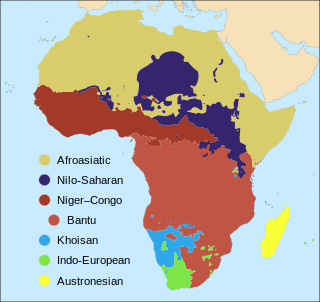
The number of languages natively spoken in Africa is variously estimated at between 1,250 and 2,100, and by some counts at over 3,000. Nigeria alone has over 500 languages, one of the greatest concentrations of linguistic diversity in the world. The languages of Africa belong to many distinct language families, among which the largest are:
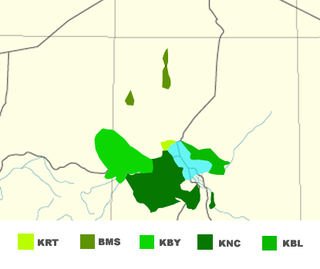
Kanuri is a Saharan dialect continuum of the Nilo–Saharan language family spoken by the Kanuri and Kanembu peoples in Nigeria, Niger, Chad and Cameroon, as well as by a diaspora community residing in Sudan.
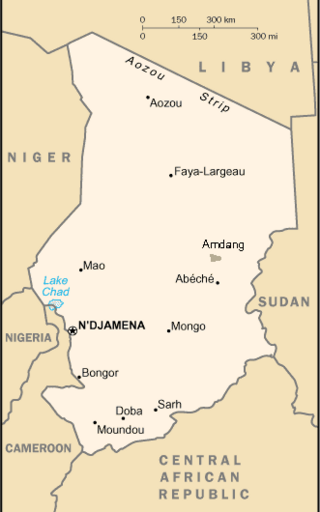
Amdang is a language closely related to Fur, which together constitute a branch of the Nilo-Saharan language family. It is mainly spoken in Chad, north of the town of Biltine, and sporadically elsewhere in Ouaddaï Region. There are also small colonies of speakers in Darfur near Woda'a and Fafa, and in Kordofan in the Abu Daza district and at Magrur north of Bara. Most of the ethnic group now speaks Arabic.

Daza is a Nilo-Saharan language spoken by the Daza people inhabiting northern Chad and eastern Niger. The Daza are also known as the Gouran (Gorane) in Chad. Dazaga is spoken by around 700,000 people, primarily in the Djurab Desert region and the Borkou region, locally called Haya or Faya-Largeau northern-central Chad, the capital of the Dazaga people. Dazaga is spoken in the Tibesti Mountains of Chad, in eastern Niger near N'guigmi and to the north. It is also spoken to a smaller extent in Libya and in Sudan, where there is a community of 3,000 speakers in the city of Omdurman. There's also a small diaspora community working in Jeddah, Saudi Arabia.
Nobiin, also known as Halfawi, Mahas, is a Northern Nubian language of the Nilo-Saharan language family. "Nobiin" is the genitive form of Nòòbíí ("Nubian") and literally means "(language) of the Nubians". Another term used is Noban tamen, meaning "the Nubian language".
The Zaghawa people, also called Beri or Zakhawa, are an ethnic group primarily residing in southwestern Libya, northeastern Chad, and western Sudan, including Darfur.

The Saharan languages are a small family of languages across parts of the eastern Sahara, extending from northwestern Sudan to southern Libya, north and central Chad, eastern Niger and northeastern Nigeria. Noted Saharan languages include Kanuri, Daza, Teda, and Zaghawa. They have been classified as part of the hypothetical but controversial Nilo-Saharan family.
Berta proper, a.k.a. Gebeto, is spoken by the Berta in Sudan and Ethiopia. As of 2006 Berta had approximately 180,000 speakers in Sudan.
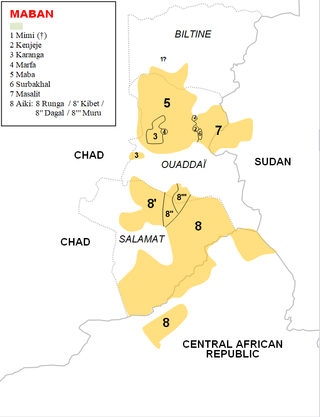
The Maban languages are a small family of languages which have been included in the proposed Nilo-Saharan family. Maban languages are spoken in eastern Chad, the Central African Republic and western Sudan (Darfur).
Dinka is a Nilotic dialect cluster spoken by the Dinka people, a major ethnic group of South Sudan. There are several main varieties, such as Padang, Rek, Agaar, Ciec, Apaak, Aliep, Bor, Hol, Nyarweng, Twic East and Twic Mayardit, which are distinct enough to require separate literary standards. Jaang, Jieng or Muonyjieng is used as a general term to cover all Dinka languages. Recently Akutmɛ̈t Latueŋ Thuɔŋjäŋ has proposed a unified written grammar of Dinka.

Chad has two official languages, Arabic and French, and over 120 indigenous languages. A vernacular version of Arabic, Chadian Arabic, is a lingua franca and the language of commerce, spoken by 40–60% of the population. The two official languages have fewer speakers than Chadian Arabic. Standard Arabic is spoken by around 615,000 speakers. French is widely spoken in the main cities such as N'Djamena and by most men in the south of the country. Most schooling is in French. The language with the most first-language speakers is probably Ngambay, with around one million speakers.
Naba is a Nilo-Saharan language spoken by approximately 500,000 people in Chad. Those who speak this language are called Lisi, a collective name for three closely associated ethnic groups, the Bilala, the Kuka and the Medogo, that represent the three dialects in which Naba is subdivided. They live mainly in the Batha Prefecture, but the Kuka are also in Chari-Baguirmi. Ethnologue estimates the lexical similarity among the three dialects to be no less than 99%. Arabic is often spoken as a second language.
Awlad Mana is an ethnic group of Sudan. It is a minority, that speaks Zaghawa, a Chad-Saharan language. They number more than 150,000 people.
Kanembu is a Nilo-Saharan language spoken in Chad by the Kanembu people. It is also spoken by a smaller number of people in Niger. It is closely related to Kanuri.
Kajakse is an Afro-Asiatic language spoken in eastern Chad.
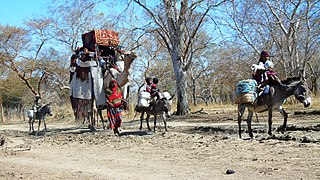
The population of Chad has numerous ethnic groups. SIL Ethnologue reports more than 130 distinct languages spoken in Chad.

The Zaghawa or Beria alphabet, Beria Giray Erfe, is an indigenous alphabetic script proposed for the Zaghawa language of Darfur and Chad.
Maba is a Nilo-Saharan language of the Maban branch spoken in Chad and Sudan. It is divided into several dialects, and serves as a local trade language. Maba is closely related to the Masalit language. Most speakers of Maba reside in Chad with 542,000 speakers as of 2019. In 2022 there were 28,000 speakers in Sudan where the language is known as Sulaihab.
Afitti is a language spoken on the eastern side of Jebel el-Dair, a solitary rock formation in the North Kordofan province of Sudan. Although the term ‘Dinik’ can be used to designate the language regardless of cultural affiliation, people in the villages of the region readily recognize the terms ‘Ditti’ and ‘Afitti.’ There are approximately 4,000 speakers of the Afitti language and its closest linguistic neighbor is the Nyimang language, spoken west of Jebel el-Dair in the Nuba Mountains of the South Kordofan province of Sudan.










